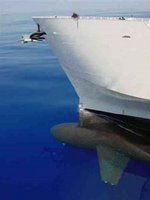Small Boats

The tragic terror attack in Mumbai and its maritime nexus represents further cause for action on an effective international and domestic approach to small vessel security. After hijacking a fishing vessel, the terrorists used off-the-shelf GPS technology to navigate from Karachi, Pakistan to Mumbai and then simply rowed ashore in inflatable dinghies. They didn’t make much of an effort to conceal their movements.
Such brazen activity would have been detected on land but the water is a much different environment. In the maritime domain, thousands of small vessels ply international or coastal waters with relative anonymity. With limited awareness offshore, law enforcement entities are forced to respond to unfolding maritime events instead of preventing them.
The Coast Guard articulated these challenges in a 2007 report.
There is no singular solution to the security threat presented by small vessels. The cooperative effort to reduce this threat, and mitigate potential impacts cuts across borders, jurisdictions and agencies. It requires a collaborative effort across government, the private sector and the international community.
Significant progress has been made to reduce the risks. Efforts have included technology, information sharing, improved operational capability, as well as legal regimes. Examples include:
Such brazen activity would have been detected on land but the water is a much different environment. In the maritime domain, thousands of small vessels ply international or coastal waters with relative anonymity. With limited awareness offshore, law enforcement entities are forced to respond to unfolding maritime events instead of preventing them.
The Coast Guard articulated these challenges in a 2007 report.
The emergence of transnational threats: Transnational criminals, pirates, and terrorists seek to exploit the complexity of the maritime domain and the vulnerabilities of the global supply system. Weapons of mass destruction (WMD), contraband smuggling, and small vessel threats, such as water-borne improvised explosive devices (WBIEDs), represent the greatest risks from terrorism in the maritime domain. Today's trafficking of drugs, migrants, and contraband by criminals is becoming increasingly sophisticated and threatening as well.I recently wrote an article on the new approach needed to counter the small vessel threat consistent with our maritime security strategy. To mitigate the small vessel threat, law enforcement agencies need greater maritime domain awareness, appropriate legal regimes, and partnerships across the public and private sector to implement risk-based solutions. You can read the article (PDF).
The vastness, anonymity, and limited governance of the global maritime domain: The maritime domain, by its nature, creates its own challenges. Legitimate uses and criminal threats are growing in a realm that spans the globe, has limited governance, and provides little transparency of activity (particularly for smaller vessels). This creates tension between recognized legal regimes and the emerging need for greater security and safety -- U.S. Coast Guard Strategy for Maritime Safety, Security and Stewardship (Download PDF)
There is no singular solution to the security threat presented by small vessels. The cooperative effort to reduce this threat, and mitigate potential impacts cuts across borders, jurisdictions and agencies. It requires a collaborative effort across government, the private sector and the international community.
Significant progress has been made to reduce the risks. Efforts have included technology, information sharing, improved operational capability, as well as legal regimes. Examples include:
- Improved international regulation through the International Maritime Organization
- International cooperative efforts to enhance global maritime domain awareness
- Department Small Vessel Security Summits and Strategy
- National Association of Boating Law Administrator initiatives to improve registration requirements
- Self-propelled Semi-submersible legislation
- Development of advanced interdiction capability and capacity
Admiral Thad Allen
Commandant, U.S. Coast Guard
Labels: Coast Guard, partnerships, risk, small vessels

1 Comments:
I scanned your blog entry and the article (linked). Homeland security is not my area of expertise, but I noticed that you touch on all of the elements that push and pull in any organization:
1. Strategic Vision (e.g. legislation, The Small Vessel Security Strategy, goals, etc.)
2. Resource Management (e.g. implementation of legislation, standards, etc.)
3. Customer Service (e.g. legitimate commercial traffic and American boaters)
4. Membership Potential (e.g. the various players and stakeholders who are part of the solution)
You say you need a new approach to counter the risks of the small
vessel threat in your ports and on waterways.
It is difficult to strategize when all of the elements seem like separate, demanding domains. The Organizations Alive! Model specifically describes how these domains are critically interdependent. (I know you know that, but can you articulate it easily?)
This is complex. I am in no position to advise, but I know the Model can help you think it through.
By Jan Yuill, At
December 10, 2008 10:08 AM
Jan Yuill, At
December 10, 2008 10:08 AM
Post a Comment
Create a Link
<< Home